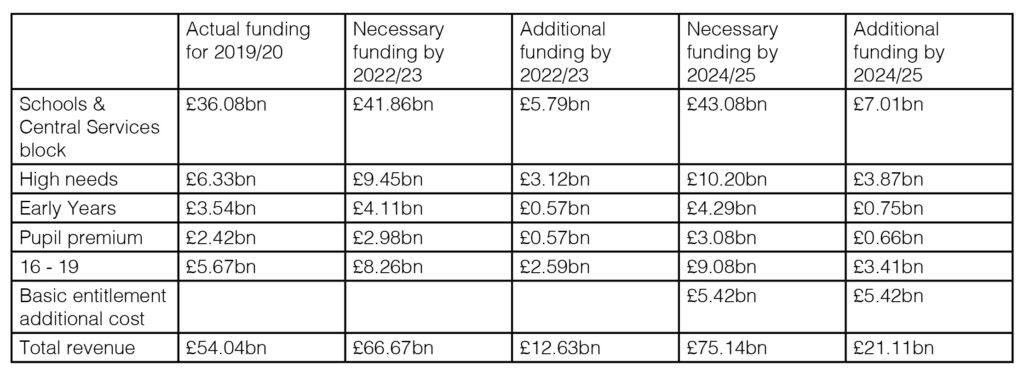Coalition unveils long-term funding plan to reverse education cuts

A coalition fighting for improved funding for education today sets out a long-term plan to reverse the cuts which have caused so much damage to schools and colleges.
It shows that a total of £12.6bn extra would be needed by 2022/23.
The analysis is backed by three leading education unions, the National Education Union (NEU), the Association of School and College Leaders (ASCL), and the National Association of Head Teachers (NAHT), as well as the f40 education fair funding campaign group, which is made up of 42 local authorities who are among the lowest funded for education in England.
For the first time it provides a complete assessment of the amount of funding needed across early years, primary and secondary schools, 16-19 education, and high needs up to the age of 25, in order to reverse real-terms cuts which have devastated the education sector over the past few years.
The coalition is proposing a phased implementation plan over the next four years to 2022/23. It shows how the £3bn one-year boost that Theresa May and Philip Hammond are reported to be on the verge of agreeing could be a starting point for a much-needed long-term investment in the sector.
ASCL has also carried out its own analysis, in which it proposes an additional investment of £5.4bn over the following two years, from 2023/24 to 2024/25, to meet the basic expectation on schools and ensure that every child is taught by a qualified teacher in classes of no more than 30 pupils.
Education cuts have caused immense damage resulting in rising class sizes, cuts to courses, reduced support for students, and huge pressure on funding for children with special educational needs, which has resulted in a legal challenge to the Government by desperate parents.
Several schools now close early on Fridays to save money, and many are appealing to parents for donations to meet the cost of classroom basics and other equipment.
Sixth forms and colleges have suffered devastating cuts, including the closure or impending closure of more than 70 school sixth forms over the past three years.
ASCL General Secretary Geoff Barton said:
“There are no political games going on here where we pitch high in the hope that the Government will meet us part way.
“This is a rigorous and reasonable analysis of the funding required to reverse real-terms cuts and provide schools and colleges with enough money to deliver the standard of education society expects of them.
“The fact that so much more money is needed is not a case of us being unrealistic, but a reflection of the totally inadequate level of funding currently provided by the Government.
“Education should be seen as a vital strategic investment in our children and in our country, and this analysis provides the most complete picture yet of what that investment should look like from the early years through to 16-19 education.”
James McInnes, chairman of f40 and cabinet member for children and schools in Devon, said:
“Education unions and the f40 group have spent a lot of time looking at the real cost of education and the impact funding cuts have had on our schools and special educational needs.
“Headteachers are telling us that they simply can’t operate within the budgets they are given and that means cuts are being made to both staff and the curriculum.
“Nobody wants to see the education of our children suffering, so we need to do something now before we get long-term damage. We also want to see fairer distribution of school budgets. There are still too many inequalities that mean some schools and local authority areas receive far less than others. All children deserve an excellent education, regardless of where they live.”
NAHT General Secretary Paul Whiteman said:
“Everyone, including ministers, agrees that school budgets are at breaking point. There is also widespread agreement that it is only new money from the Treasury that will solve the school funding crisis.
“There are many ways to calculate how much more schools and colleges need to receive; the two fundamentals though are immediate short-term relief, to make up for what schools and colleges have lost, and a long-term commitment to sufficient funding in the future.”
NEU Joint General Secretary Kevin Courtney said:
“We don’t want pledges for extra funds that never materialise. We don’t want promises on the side of a bus. We need real money, for real children, in real schools.
“We’ve been doing the maths. Along with our partners in other unions, we’ve come up with a figure, a sum of money that is urgently needed if we are to stem the tide of cuts and fully fund education.
“We will be taking that figure to politicians of all parties to press our case for the investment our schools desperately need.”
The numbers
Note: Figures have been rounded
The table explained
Column 1: Shows the current budgets for 2019/20.
Column 2: Shows the budgets needed by 2022/23 to reverse the cuts – restoring in real terms the 2015 level of funding for schools, high needs, early years, and pupil premium, and restoring in real terms the 2010 level of funding for 16-19 education. This figure takes into account inflation and increases in pupil numbers.
Column 3. Shows the additional funding required to achieve these budgets compared to 2019/20.
Column 4. Shows the budgets needed by 2024/25 to keep pace with inflation, plus an additional investment to meet the basic entitlement model developed by ASCL which guarantees a qualified teacher for every class and class sizes of no more than 30.
Column 5. Shows the additional funding required by 2024/25 to achieve these budgets compared to the level of funding in 2019/20.
Implementation

For further information about the methodology











Responses